
Return to Beaker burials of Thanet - Part 1
Display Contents
QEQM Hospital, Margate (NAM05)
Introduction
Site description
Stratigraphy
The primary grave
The coffin-structure
The central burial
Radiocarbon-date
The backfills
The secondary grave
The secondary burial
The backfill
Observations
Other Beaker activity
Specialist reports:
The Skeletons
The Beaker
The Flint
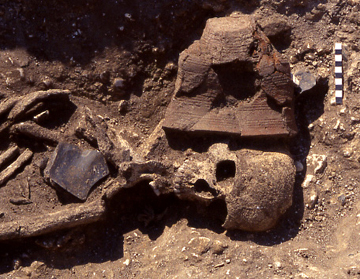
Photo by Susan Deacon (TTA)
Introduction
An
Archaeological
Excavation on the site of a new building for nurse’s
accommodation at the adjacent hospital revealed a large oval flat-grave
containing a crouched inhumation Beaker burial which had been placed
within a (subsequently decayed) wooden coffin-structure and was
accompanied by three
finely-made barbed and tanged flint arrowheads.
The Beaker grave
had subsequently been cut by the smaller, irregular
oval-shaped grave of a later (though probably virtually contemporary)
secondary crouched inhumation burial. This body was also accompanied by
a barbed and tanged flint arrowhead, though of much cruder form.
Other features revealed on site included an Earlier Neolithic pit, an Anglo-Saxon Sunken Featured Building and a group of intercutting quarry pits.
Other features revealed on site included an Earlier Neolithic pit, an Anglo-Saxon Sunken Featured Building and a group of intercutting quarry pits.
Excavating and recording the Beaker burial at QEQM
Photo by TTA
The site lay on the
west-facing slope of a valley which runs roughly
south-east/north-west and heads towards the sea and the main bay at
Margate. Further inland the valley links with the eastern extent of the
central plateau area of Thanet.
It is not known whether this valley
held a stream in ancient times, but one may think it possible.
The natural geology of the site comprised a deposit of Upper Chalk. The elevation varied from 31.7m AOD at the east of the site to 22.2m AOD on the valley bottom to the west (Gardner and Moody 2006).
The natural geology of the site comprised a deposit of Upper Chalk. The elevation varied from 31.7m AOD at the east of the site to 22.2m AOD on the valley bottom to the west (Gardner and Moody 2006).
The relationship between the Beaker
grave and the secondary grave could be clearly determined as the latter
cut through a deposit of chalk packing which had been backfilled around
the former.
Recording the Beaker burial
at QEQM
Photo by TTA
This was a
large, well-cut oval pit (2.58m long by 2.08m wide by 0.45m deep) with
vertical sides and a flat base.
The backfills likely indicated that the pit had contained a wooden coffin-structure within which had been laid a crouched inhumation burial accompanied by a pottery Beaker and three barbed and tanged flint arrowheads.
Two scenarios concerning the deposition of the burial are possible. One is that a large, pre-existing, chalk-filled pit had been subsequently re-cut to take the Beaker burial (Gardner and Moody 2006). In this scenario perhaps a smaller coffin structure (fitting the ‘void’ noted below) may have been placed within and backfilled around with soil. The alternative is that the pit was dug solely to take the coffin and was subsequently backfilled (around the coffin-structure) by chalk spoil.
The backfills likely indicated that the pit had contained a wooden coffin-structure within which had been laid a crouched inhumation burial accompanied by a pottery Beaker and three barbed and tanged flint arrowheads.
Two scenarios concerning the deposition of the burial are possible. One is that a large, pre-existing, chalk-filled pit had been subsequently re-cut to take the Beaker burial (Gardner and Moody 2006). In this scenario perhaps a smaller coffin structure (fitting the ‘void’ noted below) may have been placed within and backfilled around with soil. The alternative is that the pit was dug solely to take the coffin and was subsequently backfilled (around the coffin-structure) by chalk spoil.
large oval Beaker grave
Around the left and right-hand side can be seen the deposit of chalk which was the primary backfill deposit around the coffin-structure
The soil backfill of the smaller secondary grave can be seen to cut the chalk fill across the top right-hand corner
A small break in the circuit of the chalk backfill towards the base of the grave (below the scale and the black plastic liner) is the result of the previous evaluation of part of this feature by Archaeology South East earlier in the year
Pre-excavation photo of the two grave-pits
Scales in 0.5 metre divisions
Photo by TTA
The (now decayed)
coffin-structure
was rectangular and
steep-sided. It may have comprised a large wooden box-like
construction or could have been a hollowed-log (a maximum of 2.19m long
by 1.26m wide, with another partial soil-mark of 1.84m long by 0.64m
wide perhaps denoting an internal void).
This coffin-structure had been set within an oval pit and orientated approximately north-south down the long axis of the grave.
This coffin-structure had been set within an oval pit and orientated approximately north-south down the long axis of the grave.
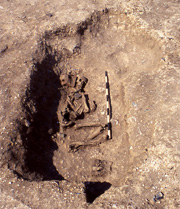
The QEQM Beaker burial
Scale in 10 centimetre divisions
Photo by Susan Deacon (TTA)
Inside the coffin-structure
was the skeleton of a strong, muscular
adult male
approximately 40-50 years of age (Tatham in Gardner and
Moody 2006). He
had been laid on his left-hand side with his head to the north and
facing east.
A Beaker had been positioned behind the man’s head and as discovered was laying over towards the head in a slightly inverted position. The burial was also accompanied by three finely-made barbed and tanged flint arrowheads, found behind his lower back. Two were of Conygar Hill type and one was of Green Low type (Green 1980).
A Beaker had been positioned behind the man’s head and as discovered was laying over towards the head in a slightly inverted position. The burial was also accompanied by three finely-made barbed and tanged flint arrowheads, found behind his lower back. Two were of Conygar Hill type and one was of Green Low type (Green 1980).
A sample of bone from the
Beaker burial was radiocarbon-dated to between 2350-2270 BC
(37.6%) / 2460-2200 BC (95.4%), (Wk 18733).

Fingernail-rusticated Beaker sherds and a Beaker base from the backfill of the Beaker grave
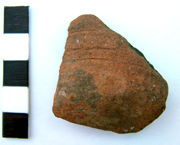
Following the deposition of
the coffin-structure and its contents pure chalk had been backfilled
around it.
Soil had infilled the interior of the coffin-structure, presumably after any lid that may have covered the coffin had decayed.
Sherds from at least two other Beakers (one fingernail-rusticated) were present in the fill, along with some contemporary flint flakes. Unusually however there was a distinct lack of any earlier, residual flintwork (absent by chance or purposely cleared and excluded perhaps?).
Soil had infilled the interior of the coffin-structure, presumably after any lid that may have covered the coffin had decayed.
Sherds from at least two other Beakers (one fingernail-rusticated) were present in the fill, along with some contemporary flint flakes. Unusually however there was a distinct lack of any earlier, residual flintwork (absent by chance or purposely cleared and excluded perhaps?).
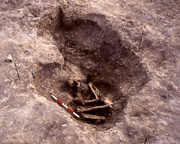
The secondary grave at QEQM
Photo by TTA
Scale in 0.2 metre divisions
The Sutton B barbed and
tanged flint arrowhead
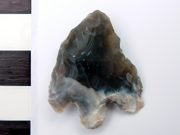
It was discovered inside the skull of the secondary burial during post-excavation work by Natasha Ransom
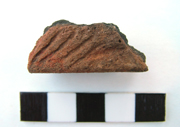
Early Bronze Age base sherd from the backfill of the secondary grave
The secondary grave was a
smaller, shallower and more roughly cut irregular
oval-shaped
pit (1.30m long by 0.86m wide by 0.26m deep). It had been dug across
the north-east corner of the larger grave-pit containing the
Beaker burial.
The secondary burial
The
secondary
burial held the remains of an adult female, perhaps 25-35 years of age
(Tatham in Gardner and Moody 2006). She had been laid on her right-hand
side, facing east.
A barbed and tanged flint
arrowhead of crude ‘Sutton B’ form (Green
1980) was recovered from inside the skull during post-excavation work.
It is somewhat
asymmetrical (which may represent reworking)
but is otherwise fresh and might also have been made for depositing
with the body - though by a much less skilled flintknapper than the one
who made the
arrowheads
found in the Beaker burial .
The position of the arrowhead suggests it may have originally been placed very close to the head of the deceased and had seen a significant degree of post depositional movement.
The position of the arrowhead suggests it may have originally been placed very close to the head of the deceased and had seen a significant degree of post depositional movement.
The circumstances of the
burials suggest a close, perhaps family bond
between these two people.
Both burials probably occurred in a relatively short period of time and demonstrate that the Beaker flat-grave was visibly marked in some way on the ground surface (perhaps by a small mound at the very least; no post-holes were observed).
Both burials probably occurred in a relatively short period of time and demonstrate that the Beaker flat-grave was visibly marked in some way on the ground surface (perhaps by a small mound at the very least; no post-holes were observed).
East-facing Beaker burials
A similar preference has been noted in Yorkshire, where male Beaker burials were laid on their left-hand side, facing east and seemed to be reversing a trend seen in their Neolithic burials which generally were placed on their right-hand side and faced west (Tuckwell 1975).
The secondary burial had also been laid facing the same easterly direction, a circumstance which seems to occur fairly frequently in Thanet Beaker burials.
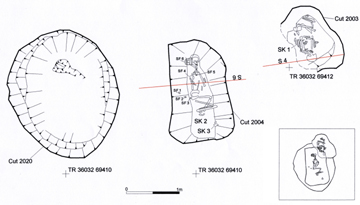
Barbed and tanged flint arrowhead from Drapers Mills
Other evidence of Beaker-associated
activity nearby comes from the site of Drapers Mills School, Margate.
An excavation in 2005 by the Trust for Thanet Archaeology (DMM05) revealed a single sherd of rusticated Beaker which likely came from a feature which had been disturbed by later activity on the site. Flintwork recovered from the same feature included some scrapers which could well have been Beaker Period. Taken together it seemed likely that a Beaker pit had existed there.
Closeby another excavation conducted previously by the Thanet Archaeological Unit (DMS80/81) uncovered what may have been the entrance shaft of a flint mine. The later backfills of this feature produced the finest and most delicate barbed and tanged flint arrowhead yet discovered on Thanet. While not actually Beaker associated, this find should date from the Beaker Period or Early Bronze Age.
An excavation in 2005 by the Trust for Thanet Archaeology (DMM05) revealed a single sherd of rusticated Beaker which likely came from a feature which had been disturbed by later activity on the site. Flintwork recovered from the same feature included some scrapers which could well have been Beaker Period. Taken together it seemed likely that a Beaker pit had existed there.
Closeby another excavation conducted previously by the Thanet Archaeological Unit (DMS80/81) uncovered what may have been the entrance shaft of a flint mine. The later backfills of this feature produced the finest and most delicate barbed and tanged flint arrowhead yet discovered on Thanet. While not actually Beaker associated, this find should date from the Beaker Period or Early Bronze Age.
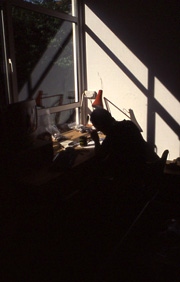
Photo by Emma Boast
Click on the links below if you would
like to read some short summaries
of the specialist reports on the following subjects:
The skeletons
The Beaker
The flint arrowheads
TTA - Trust for Thanet Archaeology.
WK - University of Waikato.
Gardner O.W. and Moody G.A. 2006. Queen Elizabeth the Queen Mother Hospital, St. Peter’s Road, Margate, Kent. Trust for Thanet Archaeology report
Green H. Stephen 1980. The flint arrowheads of the British Isles. BAR British Series 75.
Kinnes I., Cameron F., Trow S., and Thomson D. 1998. Excavations at Cliffe, Kent. British Museum Occasional Paper no. 69.
Tatham S. 2006. The Human Bone in Gardner O.W. and Moody G.A. Queen Elizabeth the Queen Mother Hospital, St. Peter’s Road, Margate, Kent. Trust for Thanet Archaeology report, Part 4.
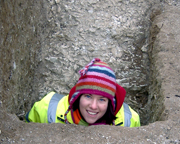
Susan Deacon
Hat scale in 0.015 metre divisions approximately
I would like to thank all those who
participated on this excavation, namely Susan Deacon and Natasha
Ransom, Oliver Gardner, Phil Lanzon, Ges Moody (Directing), Bob Pantony and John Villette.
I would also like to take this opportunity to acknowledge the efforts of Susan Deacon (pictured left) who did sterling work for Thanet Trust from 2003-2006 (in all weathers, the most inclement of which were inside the office during winter time) and who has now returned to her native Australia.
I would also like to take this opportunity to acknowledge the efforts of Susan Deacon (pictured left) who did sterling work for Thanet Trust from 2003-2006 (in all weathers, the most inclement of which were inside the office during winter time) and who has now returned to her native Australia.
Version 1 - Posted 16.12.06
All
content © Trust for Thanet Archaeology